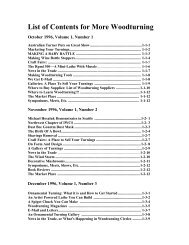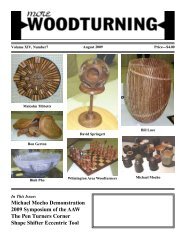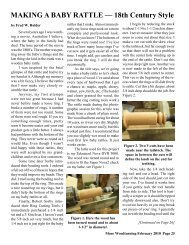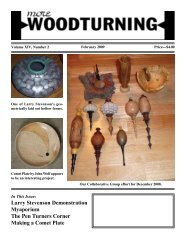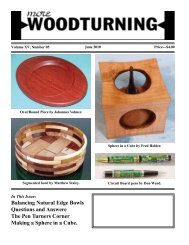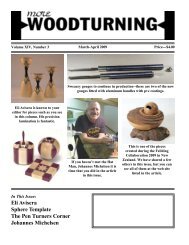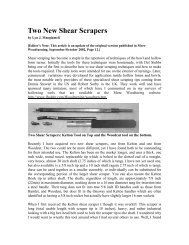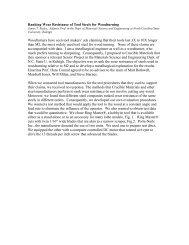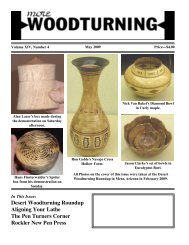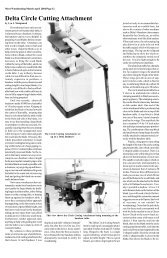A Sampling of P&N Woodturning Tools(June 2004) - More ...
A Sampling of P&N Woodturning Tools(June 2004) - More ...
A Sampling of P&N Woodturning Tools(June 2004) - More ...
- No tags were found...
Create successful ePaper yourself
Turn your PDF publications into a flip-book with our unique Google optimized e-Paper software.
<strong>More</strong> <strong>Woodturning</strong>/<strong>June</strong> <strong>2004</strong>/Page 4A <strong>Sampling</strong> <strong>of</strong> P&N <strong>Woodturning</strong> <strong>Tools</strong>by Lyn J. MangiameliP&N woodturning tools comefrom the Australian company <strong>of</strong> Patience& Nicholson. I first learned <strong>of</strong>these tools from Richard Raffan, whomentioned he regularly used them. Inever gave much thought to them afterthat, as they have never been availablein the U.S. from any <strong>of</strong> the bigwoodturning suppliers. That changedrecently, when first Lee Valley, and morerecently Craft Supplies, decided to pickup a moderate selection <strong>of</strong> unhandledP&N tools (there are also a few smallsuppliers such as Rich Johnson in California).I was particularly pleased to seethe tools <strong>of</strong>fered without handles. Thelarger my tool collection grows, themore I appreciate how unhandled toolscan be stored compactly. <strong>More</strong> importantly,I find that matching unhandledtools to a through-bored steel handleallows for greater control <strong>of</strong> unsupportedshaft length, and allows forgreater consistency <strong>of</strong> working characteristicsover the tool’s life. This consistencyis achieved as one initially can seatthe long shaft more deeply in the handle,then later seat it more shallowly as thetool shortens with sharpening, thus maintaininga single exposed shaft length overa greater portion <strong>of</strong> the tool’s life. Finally,purchasing an unhandled tool allowsthe turner to choose handle length,weight and even handle material (steel,aluminum or wood) to suit individualpreference.The only downside I find is thatmany <strong>of</strong> the P&N round tool shafts are12 mm in diameter, which is sufficientlyundersized from 1/2 inch (which is approximately12.7 mm), to make thesetools fit rather loosely in steel handles<strong>of</strong> 1/2 inch bore (e.g., Kelton, Oneway& Jordan). They will work, as the setscrews <strong>of</strong> these handles will take up theslack, but a tighter fit would be desirable.This is also a warning for thosewho would drill out a store bought orcustom wooden handle. Don’t use a1/2 inch drill bit, but instead use a smallerfractional size or obtain a metric 12 mmbit.Unfortunately, many <strong>of</strong> the largerdiameter tools, such as the 32mm roughinggouge, 16 mm Bowl gouge and22mm Supa gouge have the last 2 ormore inches <strong>of</strong> their shafts turned downto 12 mm. It would be great if the NorthAmerican importers could specify theseshafts to be necked down to a 1/2 inchor 13 mm size instead. [After viewing adraft copy <strong>of</strong> this article, P&N now intendsto change to a 1/2 inch shank sizeto better fit the commercial handles commonlyavailable in North America. Theseshould become available when presentstock is depleted.] Indeed, with the 16mm bowl gouge (which very closely approximates5/8 <strong>of</strong> an inch), it would behighly desirable to have this gouge main-Chart Showing the P&N <strong>Tools</strong> the Author has used.Tool Dimensions Overall Flute Length Comments HandlesLengthParting tool 3mm X 12mm 9-1/4 inch NA Flat sided Fits adequately in Kelton,Oneway, Jordan handleswith 1/2 inch bore.Parting tool 6mm X 12mm 9-1/4 inch NA Flat sided Fits well in Kelton,Oneway, Jordan handleswith 1/2 inch bore.Beading Tool 10mm X 10mm 9-1/4 inch NA Square shaft Fits well in Kelton orOneway handles with 1 / 2inch bore. Very tight fitin Jordan handle unlessedges roundedSkew 30mm X 8 mm 9-1/4 inch ~6-1/4 inch Meets Lacer Fits well in Kelton,~1-3/16 X including working criteria <strong>of</strong> flat Oneway, Jordan handles5/16 inch 2-1/4 inch length on long point edge and with 1/2 inch bore.tang long point side rounded shortpoint edgeRoughing 32 mm 10-1/4 5-25/32 Made from round 12 mm tang fits loosely inGouge ~ 1-1/4 inch including stock so upper edges 1/2” bore steel handles*2 inch tang curve in slightlyDetail Gouge 8mm 10 inch 6-5/8 inch Comes shaped Fits well in 5/16 inchstraight across bore <strong>of</strong> Kelton KH-1(“Mini”) HandleDetail Gouge 10mm 10 inch 6-5/8 inch Comes shaped Fits well in 3/8 inchstraight across bore <strong>of</strong> Kelton KH-1(“Mini”) HandleDetail Gouge 12mm 10 inch 6-5/8 inch Comes shaped Fits loosly in 1/2 inchstraight across bore <strong>of</strong> steel handlesSpindle Gouge 10mm 10 inch 6 inch Comes with fingernail Fits well in 3/8 inchgrindbore <strong>of</strong> Kelton KH-1(“Mini”) HandleBowl Gouge 10mm 10 inch 6 inch Comes ground Fits well in 3/8 inchstraight across, bore <strong>of</strong> Kelton KH-1parabolic/ U flute (“Mini”) HandleBowl Gouge 12mm 10 inch 6-5/8 inch Comes ground 12 mm tang fits looslystraight across in 1/2 inch bore <strong>of</strong>parabolic/U flute steel handlesBowl Gouge 16mm 11 inch 7 inch Comes ground Last 2 inches <strong>of</strong> shaftstraight across necked down to 12mmparabolic/U flute which makes it fitloosely in 1/2 bore<strong>of</strong> steel handles*Bowl Gouge 22mm 12 inch 7-1/4 inch Heavy walled Last 2-3/8 inches <strong>of</strong> shaft“Supa Gouge” ~ 7/8 inch including U-shaped flute necked down to 12mm2-3/8 tamg which makes it fitloosely in 1/2 bore<strong>of</strong> steel handles** Future production to use 1/2 inch shank for better fit in commercial steel handles.tain a uniform length throughout its shaft,which would allow it to fit quite well insteel handles <strong>of</strong> 5/8 inch bore (again, theKelton, Oneway and Jordan, for example,as well as the Hamlet) and <strong>of</strong>fer greaterchoice over how deeply the tool couldbe seated in a steel handle. I wouldreally like to see this happen, but Ihave less confidence this change willtake place, as the 12mm (and future1/2 inch) diameter will be preferred bysome making their own wooden handles.All <strong>of</strong> P&N <strong>of</strong>ferings are credibleM2 HSS tools, most being a comparablealternative to the standard M2
<strong>More</strong> <strong>Woodturning</strong>/<strong>June</strong> <strong>2004</strong>/Page 5Top, side, and bottom views <strong>of</strong> theDetail Gouge.Crown, Hamlet, Henry Taylor andSorby fare. P&N follows the NorthAmerican convention <strong>of</strong> sizing all gougesaccording to the external diameter <strong>of</strong> thetool shaft, regardless <strong>of</strong> flute style. Thedetail gouges have very shallow flutes,the spindle gouges are slightly deeper,and the bowl gouges have deep fluteswhich to my eye appear slightly parabolicin shape, though P&N calls themU shaped. The flutes are adequately finished,about the same as a Glaser, thoughnot as polished as a Sorby. Of course,any flute will soon become polished ifyou regularly maintain it with a slipstone.Hardness varies from 58 to 65 Rockwelldepending on intended use. Some <strong>of</strong> theolder P&N tools have a sandblasted finish(much like you’d find on a Glaser),but most recent production goes thougha final “straw tempering” process andcomes with a black oxide finish.Of the several tools I have fromthe P&N line, three strike me as exemplaryin design and performance. Thefirst <strong>of</strong> these is the roughing gouge. Tomy knowledge, P&N is unique in <strong>of</strong>feringroughing gouges milled from roundbar stock, rather than the usual practice<strong>of</strong> forging from flat stock. This allowsfor a much heavier than average roughinggouge (relative to others <strong>of</strong> the samesize) and a very sturdy transition fromside walls to tang. The round tang is farstronger than the narrow flat tangs <strong>of</strong>other roughing gouges, and allows thegouge to fit into the round bores <strong>of</strong> steelhandles. Milling from round stock alsoallows for side walls <strong>of</strong> a constant radius,unlike most roughing gouges wherethe upper portion <strong>of</strong> the flute is flared.The potential down side <strong>of</strong> this approachis that with the deep flute ground belowcenter, the upper section <strong>of</strong> the side wallscurve in slightly. I have not found this tobe a problem, as I don’t tend to cut inthat area <strong>of</strong> my roughing gouges. Forthose that are concerned, one can lightlygrind down the upper corners until theGlaser and the Supa Bowl Gouge are compared in this photo.The P&N Roughing Gouge. Ground from solid stock it represents a verysolid tool.A Michael Hosaluk groundroughing gouge.front pr<strong>of</strong>ile is exactly a hemisphere. Youcan also try a tip from Michael Hosaluk(one <strong>of</strong> the first North American P&Nimporters) who notches the upper corners(going back about 3/8 <strong>of</strong> an inch)<strong>of</strong> the gouge (see attached photo).Michael does this so that he can get aclean cut on the side <strong>of</strong> details (such assquare shoulders on tenons) with thisside bevel when the gouge is held withthe flute parallel to the tool rest.The second is the 22mm SupaGouge. This is a very ruggedly designedtool with a deep U shaped flute and thicksidewalls. Mine is almost 7/8 inches inoutside diameter. One could also get bywith using this gouge as a small spindleroughing gouge, and several turners haveSkew tip on the long point side.reported preferring it over a traditionalroughing gouge. Most will choose it forinitial roughing out <strong>of</strong> bowls, or use itsdiameter (and thus strength) to get bywith long extensions over the tool restwhen working with very deep bowls.For those <strong>of</strong> you who just can’t justifythe expense <strong>of</strong> a 3/4 inch V-15 Glaser,but would like a large rugged bowlgouge, the P&N Supa is very affordablyThe P&N Skew Chisel.Skew tip on the short point side.eral purpose skew. Its width makes it aparticularly good choice for both begin-CROWN HAND TOOLS LTD.Excelsior Work, Burnt Tree Lan, Hoyle StreetSheffield, S3 7EX Englandpriced. I keep mine with a traditionalstraight across grind, which works verywell with the large deep U shape <strong>of</strong> theflute.The third is their skew. Many arefamiliar with the excellent video preparedby Alan Lacer where he demonstratesthe use <strong>of</strong> the skew, and recommendshow to form the edges <strong>of</strong> the skew foroptimal use with either the long or shortpoint. Lacer describes how to round theedges <strong>of</strong> the short point side, and leavethe long point side with a flat edge withlightly radiused corners. Fans <strong>of</strong> this configurationwill be pleased to know thatthe P&N skew comes from the factoryin this configuration, and apparently hasalways been provided this way. I find ita very effective configuration (all the reasonsfor which I won’t go into here, butinstead refer you to the Lacer tape availablefrom most major woodworkingsuppliers), and appreciate that little <strong>of</strong>my time was required to make the P&Nskew ready for some serious use. I musthave near a dozen skews, including fivedifferent Glasers, but this P&N skewhas instantly become one <strong>of</strong> my favorites.For me, it has just the right combination<strong>of</strong> width (30 mm), length, andbevel angle to make it an excellent genningand experienced skew users. It isalso a significantly thicker skew thanmost others (8 mm compared to a moreusual 6 mm), which adds to its weightand stability. P&N also <strong>of</strong>fers a narrower24 mm skew from the same thick 8mmsteel.Finally, I should comment a bitmore on their Detail Gouges. Manygouge manufacturers <strong>of</strong>fer one or twosizes <strong>of</strong> detail gouge, but P&N <strong>of</strong>fersfour, ranging from 8 mm to 16 mm(roughly 5/16 to 5/8 inches). The gougenormally comes delivered with a bluntfingernail shape which is functional, butnot my preferred. I was fortunate in thatthe North American P&N rep, GregJensen, sent me an 8 mm detail gougehe had personally ground based onsome ideas <strong>of</strong> Stewart Batty that bothGreg and Mike Mahoney have adopted.(see photo). Basically Greg freehandsharpened the gouge with a spindlegouge fingernail pr<strong>of</strong>ile, putting a 40degree bevel all around the tool, thenground <strong>of</strong>f the bevel to give a convexshape. Stuart Batty contends you preventbruising the wood with this grind,and Greg also has found it is easier tocontrol the tool when the bevel is short(and thus provides less leverage to comeout <strong>of</strong> the cut). Greg notes that Battyactually grinds the bevel <strong>of</strong>f all hisSpindle, Detail and Bowl gouges, makinghis cuts with the gouge flute as closeto a 12 o’clock position as possible,contacting the wood with the left side<strong>of</strong> the gouge. I have had only limited experiencewith this grind, but have foundit effective. However, I have a lot moretrouble maintaining the geometry (mostknow I am not fond <strong>of</strong> freehand grinding)and so for me find it best saved fora single, special use tool. In this context,I found the 8mm P&N DetailGouge to have been a good platformfor this grind, as also would be the 10mm.1999 thru 2003 Issues <strong>of</strong> <strong>More</strong><strong>Woodturning</strong> Now on CD ROMThe last five years <strong>of</strong> <strong>More</strong> <strong>Woodturning</strong>are available on CD-ROM in Adobe PortableDocument Format (*.PDF). It requires AdobeAcrobat Reader to read the files. This programcan be downloaded at several places onthe internet for free. These will work on Windows95 and 98 machines and they work onmy Windows XP machines. Cost for eachyear CD-ROM is $25.00 plus postage andpacking <strong>of</strong> $3.00 inside the United States and$5.00 outside the United States. This is a savingsover the cost <strong>of</strong> our limited number <strong>of</strong>back issues. To order, send check or moneyorder for $25.00 plus shipping for each yearordered (or MasterCard or Visa charge cardnumber and expiration date) to:<strong>More</strong> <strong>Woodturning</strong>P. O. Box 2168Snohomish, WA 98291-2168Manufacturer’s <strong>of</strong> the Worlds Largest Range <strong>of</strong> FineWoodworking HandtoolsTEL: England 114 272 3366 FAX: 114 272 5252E-Mail: info@crowntools.com Web Site: www.crownhandtools.ltd.uk



